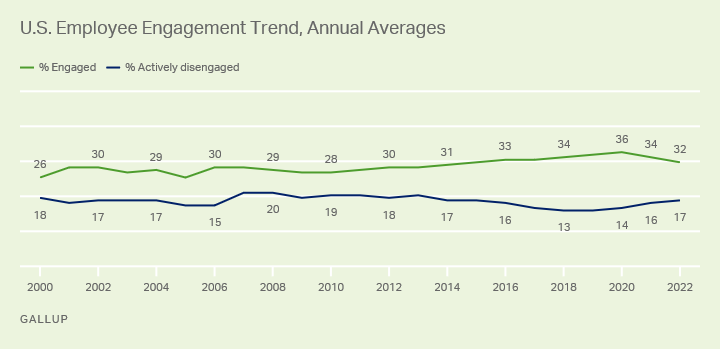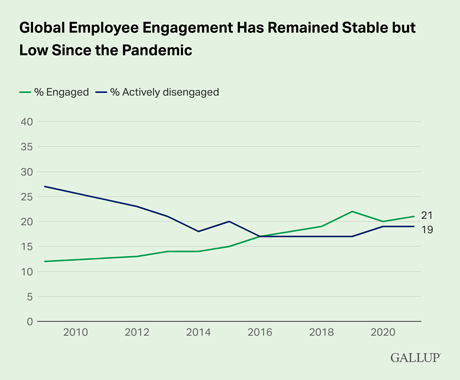Story Highlights
- U.S. employee engagement dropped two percentage points in early 2022
- Hybrid and remote workers are more engaged than on-site workers
- Engagement is higher for organizations that focus on culture and wellbeing
After trending up in recent years, employee engagement in the U.S. saw its first annual decline in a decade -- dropping from 36% engaged employees in 2020 to 34% in 2021.
This pattern has continued into early 2022, as 32% of full- and part-time employees working for organizations are now engaged, while 17% are actively disengaged, an increase of one percentage point from last year.
The ratio of engaged to actively disengaged workers in the U.S. is 1.9 to 1, down from 2.1 to 1 in 2021 and 2.6 to 1 in 2020. The annual record high is a ratio of 2.7 to 1 in 2019.
Gallup measures employee engagement by asking random samples of the working population about specific workplace elements that link to many organizational outcomes, including profitability, productivity, customer service, retention, safety and overall wellbeing. The survey was of a random sample of 14,705 U.S. full- and part-time employees.
The survey measures several workplace elements, including employees' level of agreement about clarity of expectations, opportunities for development and their opinions counting at work. In short, engaged employees are involved in and enthusiastic about their work and workplace. Actively disengaged employees are disgruntled and disloyal because most of their workplace needs are unmet.

Line chart displaying the employee engagement data in the U.S. -- in 2022 so far, engagement continues its downward trend, now at 32% engaged and 17% actively disengaged, an engagement decline of two points from the 2021 average.
Considerations
The decline began in late 2021: The 32% of engaged employees in early 2022 is equivalent to the percentage in the second half of 2021. The engagement elements that declined the most from early 2021 to 2022 were employees' level of agreement that they have clear expectations, the right materials and equipment, the opportunity to do what they do best every day, and a connection to the mission or purpose of their organization. Gallup also found an eight-point decline in the percentage of employees who are extremely satisfied with their organization as a place to work.
Job types: Healthcare workers had the greatest engagement decline (nine points) from early 2021 to early 2022. Managers saw a seven-point decline from early to late 2021 -- but have since rebounded by three points in early 2022.
Remote jobs: Employees who work exclusively remote or hybrid tend to have higher levels of engagement (37% engaged in both groups) than those who work exclusively on-site (29% engaged). This difference is approximately the same for those in remote-capable jobs and all jobs, including those that are not remote capable. Since before the COVID-19 pandemic, the decline in the percentage of engaged employees was evident across all three groups -- exclusively remote, hybrid and exclusively on-site -- but highest for employees who are exclusively remote. The decline was especially evident on engagement elements relating to clarity of expectations, materials and equipment, recognition, development, and connection to the organization's mission or purpose.
Wellbeing: Gallup recently reported a sharp drop in the percentage of employees who strongly agree that their employer cares about their overall wellbeing. Employee engagement is foundational to improving the wellbeing and resilience of a workforce because it contains elements of communication, caring, development, involvement and collaboration. These elements set the stage for developing trust -- which opens the door for addressing overall wellbeing.
Since before the COVID-19 pandemic, the decline in the percentage of engaged employees was evident across all three groups -- exclusively remote, hybrid and exclusively on-site -- but highest for employees who are exclusively remote.
What You Can Do
Learning how to increase employee engagement may seem like a daunting task. However, the good news is this: While only 32% of U.S. employees overall are engaged, there are organizations that have more than doubled this percentage. Gallup's Exceptional Workplace Award winners averaged 70% employee engagement even during a highly disruptive 2021. Here's what they do differently:
- Use their organizational culture and values to guide business decisions. Employees need to see the intended culture and values lived out daily. It is important to listen to people and act based on employees' work-life needs. The most successful organizations put their values at the center of decisions. For example, those organizations may spend more money in the short-term to do what is right for employees during a pandemic -- even if those expenditures are well beyond the original budget -- or design flexible working arrangements with employee wellbeing and performance in mind. Employees can see the organization's values lived out through decisions, which builds trust in leadership.
- Embrace flexible work environments while developing plans for the future of work. Flexibility can take on different meanings for employees, depending on the type of work they do and the ideal physical location for them to have outstanding individual performance, team collaboration and customer value. Successful organizations embrace flexibility, acknowledge that there is some ambiguity about the future and quickly respond to changes as they occur.
- Focus on employee wellbeing and acknowledging the whole person. Since work and life are blended for many employees, consider the demands of life inside and out of the workplace. Consider how career, social, financial, physical and community wellbeing affect employees, and provide resources designed to improve these important elements of wellbeing.
- Tailor communication to reach teams where they are. Transparent and creative omnichannel communication to employees and customers (e.g., podcasts, a company app, virtual town halls, YouTube) is more likely to reach and resonate with a wide variety of people in many different work-life situations. It is important to rely on local managers to keep people informed and openly discuss organizational changes with their teams.
- Enable managers to manage through times of change. Consistently upskill managers to coach their employees through their strengths. Every person has a different work-life situation, and only managers can understand these nuances and make adjustments based on how each individual best performs, collaborates and brings value to customers. It is particularly important during uncertain and difficult times to reinforce that managers focus on clear expectations, resources to do the work and giving employees an opportunity to do what they do best within their current work arrangement.
The pandemic-driven "great forced working experiment" of the past two years provided organizations and employees with an opportunity to learn from what worked well and what didn't.
With the spread of COVID-19 stabilizing in the U.S., organizational leaders may have an opportunity to put new plans in motion for the foreseeable future. How they display their organizational values through these decisions and practices -- especially through their managers -- will differentiate them from other organizations. Getting the basics of employee engagement right is a critical first step in building a resilient culture and an employment brand that attracts stars.
Create an organization where your employees thrive.
- Subscribe to the Gallup at Work newsletter to receive our latest advice and analytics delivered straight to your inbox.
- Discover how a highly engaged workplace drives performance.
- Learn more about how to maximize your employees' potential through engagement.






